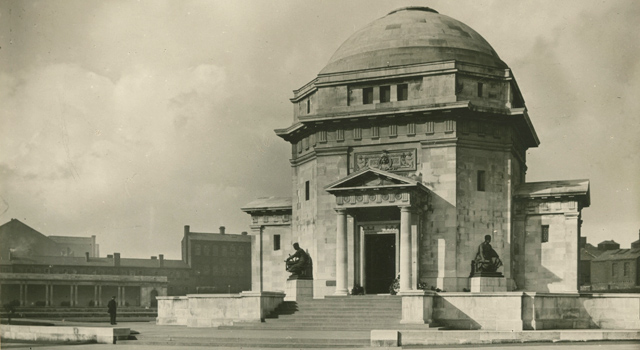Articles

One Comment
By Voices
On 14, Jul 2014 | One Comment | In Commemoration | By Voices
The Fight for the Rank and File
Birmingham’s Hall of Memory
Emma Login, PHD Student, Ironbridge International Institute for Cultural Heritage, University of Birmingham
The Hall of Memory has been an integral part of the Birmingham landscape for nearly 90 years. Originally surrounded by extensive memorial gardens and accompanied by an impressive colonnade, the Hall has clearly undergone multiple revisions since its construction. Yet, these changes are small scale compared to those undertaken throughout the memorial’s planning stages, as citizens debated exactly who and what should be remembered.
Discussions regarding the most appropriate way to commemorate Birmingham’s contribution to the First World War began whilst it was still being fought. Based on commemorative responses to earlier conflicts, few believed that the remembrance of the Great War would have any form of longevity. Sir Whitworth Wallis, Director of the Municipal Art Gallery writing for the Birmingham Gazette in 1917 pessimistically predicted:
“We no doubt imagine that the shining events of this war will never be forgotten and that the names of those who have fallen will never pass into oblivion- judging by the past these are vain hopes- a few of the important battles will doubtless be remembered, […] a few distinguished generals, famous deeds of a few winners of the Victoria Cross will be recalled from time to time, but the millions of the rank and file will cease to be remembered.
(Birmingham Gazette 17/11/1917)
As a result of these cynical projections, initial proposals were for practical memorials and focused on the battles that were fought and the weapons used to fight them. Original suggestions included a large memorial museum to be constructed “if possible in one of the parks, preferably Cannon Hill Park, which contains the Boer War memorial” and which should be “dignified, spacious, top-lighted, […] and on one floor level so as to permit easy extension” (Report of the Honorary Director January 1919). But, these plans were not well received by the people of Birmingham. The prioritisation of the memory of the conflict above that of the dead attracted widespread criticism within the local press, and as a result the scheme was swiftly dropped (Chamberlain and Francis 1919).
![Birmingham Hall of Memory, 1931 [Library of Birmingham: WK/B11/169]](http://www.voicesofwarandpeace.org/wp-content/uploads/2014/06/wk-b11-169-w.jpg) Despite this, Birmingham’s War Memorial Committee remained ardent that any memorial should be of practical benefit to the people of Birmingham. Subsequent suggestions included an imposing town hall, “with seating for 3,600 people, 50% more than the existing hall.” But, this time provisions were made to include the memory of the common solider through the addition of a Hall of Memory “intended to perpetuate the memory of the heroic dead” (Brooks et al, Birmingham War Memorial Committee). Yet, continued criticisms within local newspapers of a memorial not wholly based on commemoration and the failure to raise the £300,000 necessary for both structures resulted in one final revision to the scheme
Despite this, Birmingham’s War Memorial Committee remained ardent that any memorial should be of practical benefit to the people of Birmingham. Subsequent suggestions included an imposing town hall, “with seating for 3,600 people, 50% more than the existing hall.” But, this time provisions were made to include the memory of the common solider through the addition of a Hall of Memory “intended to perpetuate the memory of the heroic dead” (Brooks et al, Birmingham War Memorial Committee). Yet, continued criticisms within local newspapers of a memorial not wholly based on commemoration and the failure to raise the £300,000 necessary for both structures resulted in one final revision to the scheme
All practical elements were dropped and it was decided that just the symbolic Hall of Memory would go ahead. Thus eventually, after months of discussions, it was the memory of the ‘millions of rank and file’ that triumphed and which continues to provide the focus of Birmingham’s wartime commemorations today.
Submit a Comment



Comments